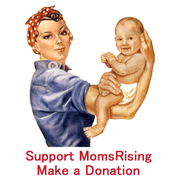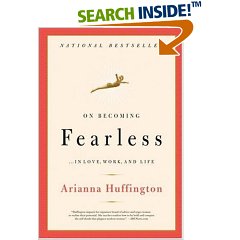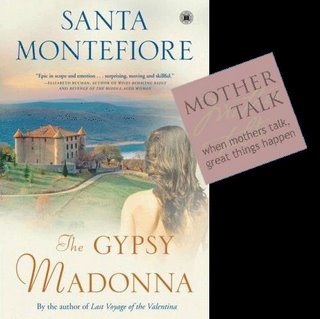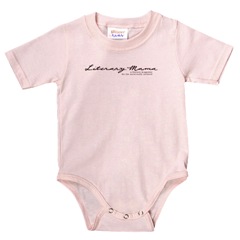
When I first read about Momsrising.org and learned that they’d produced a film version of their book, The Motherhood Manifesto, I knew I wanted to write a column about the documentary. What better movie, after all, for a mama at the movies, than one expressly focused on the situation of mothers in this country today? I ordered the film via momsrising.org and drafted my column. But something was missing. This is a consciousness-raising movie, an organizing tool. Watching it by myself, I was missing a critical component of the film’s intent.
Before I could make plans to host a house party screening myself, I found an invitation in my inbox from a woman on my prenatal yoga teacher’s email list; my youngest child is almost two but I’ve stayed on the list for the supportive community it offers. I rsvp’d, interested in meeting the other mothers.
I arrived with a pan of brownies just as the other women arrived with snacks and drinks. Our hostess’ toddler was roaming around in his pj’s, happily greeting the other mamas, an entertaining reminder of why we’d come. We quickly fell into the kind of easy playground talk common to mothers everywhere. We could have gone on for hours, though, because this time we weren’t being interrupted by our children, only slightly distracted by our hostess’ sweet boy, who roamed from one of us to the next, clambering up on the couch for a cuddle, or lolling on the floor with his dog.
When we finally sat down to introduce ourselves properly (playground chat rarely involves the background basics of name, number of children, work, etc), the conversation quickly turned more significant. We have six children between us (ranging from 20 months to 5 years), and two more on the way; one of us is pregnant with her first child, and we admired her activism and foresight in attending this screening before even becoming a mom! All of us work in some capacity, all of us are struggling to find the right balance between our jobs and our children. One of us felt she’d lost out on a job opportunity because, interviewing when she was pregnant, she was seen by the employer as an unreliable prospect. Two of us have first-hand knowledge of the better family benefits offered to working mothers in other countries (in this case, England and Canada), and have no good answer for friends and family members who ask why the US makes it so hard on working moms. One of us actually concealed her motherhood while she worked on a graduate degree in order to maintain her status in the competitive, family-hostile program (another of us has heard so many of these difficult stories about women in higher education that she is co-editing a book on the subject.) We looked forward to seeing what the movie would say to us, how much of our own stories we would recognize in the stories on film. Our hostess, having already watched the first half of the movie in preparation for this moment, started the dvd, and took her son off to bed while we settled into watch.
I won’t go into the details of the movie here, in favor of describing our reaction. I am not exaggerating when I say that the film made us laugh, and it made us cry. We all appreciated the movie’s busy mom-friendly length (just an hour), and its clarity: organized around the six-point motherhood manifesto, each section of the film presents an entertaining mix of personal stories and statistics to dramatize and elucidate the difficulties working mothers face. We sat very quietly for a moment or two after the film ended, then our hostess got out some ice cream and as we dished it up and passed the brownies around, we started to talk again, but this time with more urgency, more focus.
As we discussed what aspects of the film hit most closely home, we focused particularly on healthcare, moved by the mother in the film whose child’s medical costs bankrupted her family. It is shocking that this country doesn’t offer universal healthcare for kids: it’s a truly affordable (since kids tend to be healthy), even money-saving government expenditure (universal child healthcare would result in healthier adults.)
We discussed the vulnerability we feel as women who have altered career plans to care for our children and then wind up financially dependent on our husbands. It puts a burden of stress on us and on our marriages. We all want to work, to offer role models to our children, to contribute to our family’s financial stability, and to maintain our sense of self. Yet we continue to struggle with combining work and family in a way that gives us time for both, and we weren’t at all surprised when the film tells us that lack of family time is the main reason mothers leave the workforce.
We shared how legislation really can affect us. One of us related how a change in California’s family leave between her pregnancies means that now her husband is also considering the logistics of when to take parental leave; “he has an empathetic understanding” of the challenges she faces, she said, and it has brought a new sense of balance to their marriage.
And finally, we discussed the tricky navigation we all face between public and private life, how protective we are of the time we give as volunteers and activists because of our desire for family time, and our sadness about feeling less generous “out there,” for society, because of the powerful claims on our private time. Meanwhile, we often feel so isolated, as mothers, we’re looking for a connection beyond the connection with our children, a way to extend our nurturing beyond the boundaries of family in order to improve the world for our children and our neighbors’ children.
Momsrising.org is savvy. They know they’re trying to organize about the most exhausted, overworked segment of the population, so the film suggests quick, strategic ways to help: send an email; sign a petition; write a letter. For those of us wanting a middle ground between internet activism and street demonstrations, the website suggests tips for organizing your own local activist group. Our small group quickly wrote up a wish list of three improvements we’d like to see for families in our city, exchanged email addresses, and promised to meet again. The Motherhood Manifesto inspired the activists in us.
cross-posted at Momsrising.org











